,
28.05.2015
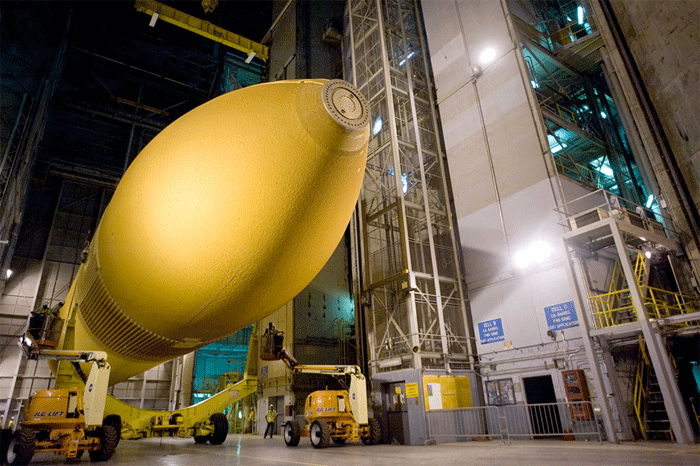
NASA's last space shuttle external tank, ET-94, seen here at the Michoud Assembly Facility in 2012, will be given to the California Science Center to go on display with Endeavour. (NASA/MAF)
.
It's a sight no one thought possible again: a complete NASA space shuttle – the winged orbiter, twin rocket boosters and a massive external tank, all authentic hardware – standing vertical as if the vehicle was about to blast off for space.
But come 2018, that's exactly what the California Science Center will be able to display, thanks to a newly-revealed agreement by NASA to donate its last remaining fuel tank built to launch the space shuttle.
"The ability to preserve an entire stack of flight hardware will make the [center's new] Samuel Oschin Air and Space Center an even more compelling educational experience," said Jeffrey Rudolph, president and CEO of the California Science Center, in an interview with collectSPACE. "It will allow future generations to experience and understand the science and engineering of the space shuttle."
The orange-brown tank, which will be transported by barge from New Orleans to California via the Panama Canal and then moved overland through the streets of Los Angeles, will be stacked with NASA's retired orbiter Endeavour and a pair of boosters that were obtained earlier. The California Science Center had planned to construct a replica of the tank until NASA agreed to donate the historic hardware for the unprecedented exhibit.
.
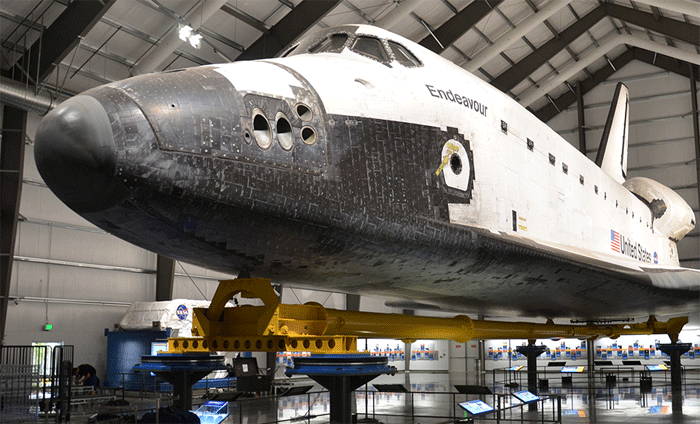
Space shuttle Endeavour, as currently exhibited by the California Science Center, will go vertical in 2018.
.
NASA awarded Endeavour to the science center in April 2011, a month before it lifted off on its 25th and final flight. After being made safe for display and flown to L.A. atop a modified 747 jetliner, the iconic spacecraft embarked on a three day, 12-mile (19-km) road trip to the center's Oschin pavilion, where it has been on exhibit since October 2012.
Number 94
The external tank served as the structural backbone of the space shuttle and fed liquid oxygen and liquid hydrogen to the three main engines mounted to the aft of the orbiter.
The tank was the shuttle's only major component that was not recovered and reused after launch. When Endeavour reached orbit on its final flight on May 16, 2011, its spent tank was jettisoned to be destroyed when it fell back into the Earth's atmosphere, just like every other external tank that launched before and after it.
Over the course of the 135-mission, 30-year program, 136 flight-qualified external tanks were constructed at NASA's Michoud Assembly Facility in Louisiana. Just one of those tanks, no. 94 (ET-94), was never launched and so it exists today.
.

External tank no. 94 (ET-94) seen outside the Michoud Assembly Facility in Louisiana. (California Science Center/Dennis Jenkins)
.
ET-94, a so-called "lightweight tank," was built at a time when NASA was transitioning to using even lighter "super lightweight tanks" to be able to launch the heavier parts needed to assemble the International Space Station. ET-94 would have likely flown on a science-dedicated mission were it not for the loss of orbiter Columbia in 2003.
"Since all of the missions after the accident were to the International Space Station – with the exception of the one high-altitude mission to service the Hubble [Telescope] – there was never an opportunity to use the tank," explained Dennis Jenkins, project director for Endeavour's display at the California Science Center.
Instead, ET-94 became a test article, used to validate the modifications made to the external tanks that enabled the shuttle fleet to safely return to flight after Columbia. It was also considered for use with NASA's new heavy-lift rocket, the Space Launch System (SLS), slated to fly in 2018.
"There was some initial interest within NASA to use ET-94 as a prototype SLS core stage but for various reasons this never happened," Jenkins stated. "NASA also examined various parts of ET-94 as part of its understanding how to build the SLS core stage."
From LA to L.A.
As it was no longer needed, ET-94 transitioned to serving as a display at Michoud. It even had a brief cameo in the 2013 movie "G.I. Joe: Retaliation," doubling as a missile.
Today, it sits in its wheeled carrier just outside the facility where it was assembled. But wheels will not help its move to the California Science Center — at least not at first.
.
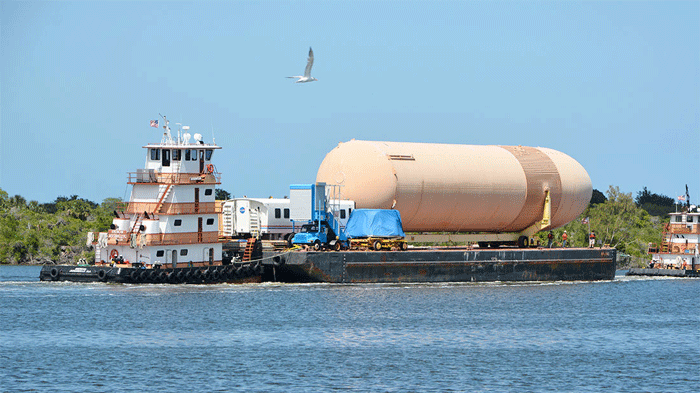
The California Science Center will ship ET-94 to Los Angeles by barge, similar in method to how an ET structural test article was transported in Florida in April 2013. (Jacksonville.com/Bob Self)
.
"Since the tank is much too large to move overland, we will barge it from Michoud, through the Panama Canal, to Los Angeles," Jenkins told collectSPACE. "The majority of that route – minus the stop in L.A. – is the same route taken by the four tanks that were sent to Vandenberg [Air Force Base] before that launch site was closed."
A commercial barge will be used to transport ET-94 on its one-way trip to California.
Once at port on the U.S. west coast, the external tank will embark on a road trip through the streets of Los Angeles, similar to the three-day journey that Endeavour took to the science center three years ago.
"The tank is not nearly as wide (32 feet versus 78 feet) or as high (35 feet versus 56 feet), but it is a bit longer (154 feet versus 122 feet). It is also lighter," Jenkins described. "Therefore, we will impact fewer utilities and this time we won't need to remove any trees on the move to Exposition Park, although we may need to trim a few to make sure they do not brush the tank as we pass."
.
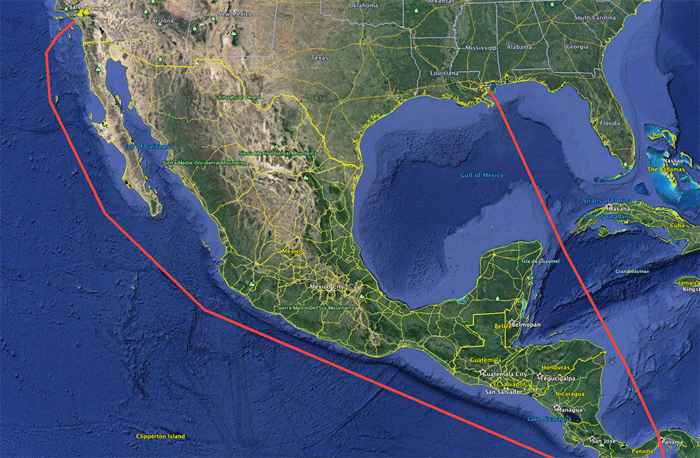
ET-94's six to eight week journey from Louisiana to Los Angeles will take it through the Panama Canal. (California Science Center)
.
ET-94's entire trip, from Michoud to the science center, is expected to take six to eight weeks to complete. Current plans call for the tank to leave Louisiana later this year or early in 2016.
"The timing is driven by the progress of some work on the ET that will take place before its journey to Los Angeles," Jenkins said. "There's some cosmetic restoration needed to fix foam where it was [earlier] removed for various tests and evaluations."
Go for stack
At the California Science Center, ET-94 will be reunited with its shuttle mounts and other hardware to get it ready for mating with Endeavour.
"About 18 months ago, NASA gave us all of the orbiter-ET attachment hardware from ET-94 to use on our [planned] replica tank," Jenkins said. "So we will need to install that hardware, along with the pressurization lines and feedlines that NASA removed several years ago."
And then ET-94 will wait.
.
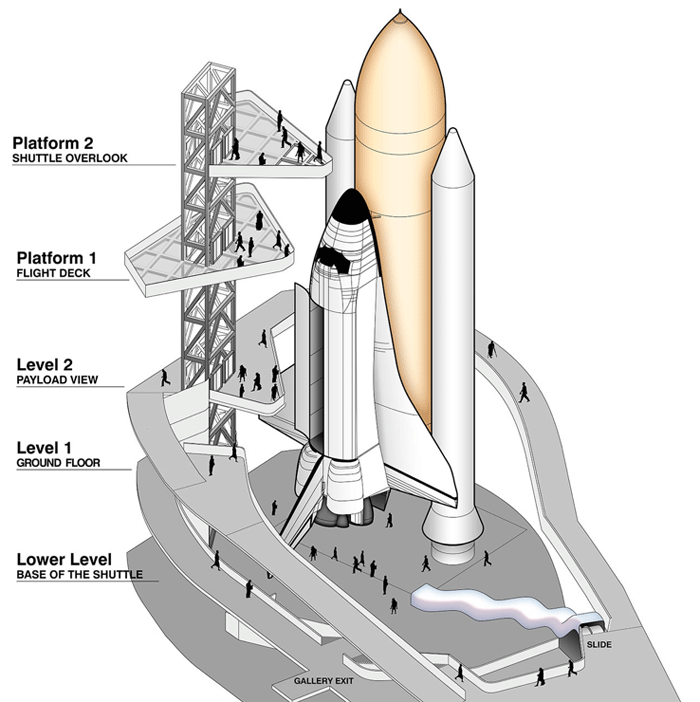
Concept drawing by ZGF Architects LLP of the California Science Center's vertical exhibit of Endeavour. (California Science Center)
.
The science center plans to debut the fully-stacked space shuttle in 2018 inside its still-to-be-built Samuel Oschin Air and Space Center, named for the late philanthropist whose family foundation made a "transformational gift" toward the exhibit.
"Our fundraising efforts are progressing well," Rudolph told collectSPACE recently. "We're nearly half way to our $250 million goal for the EndeavourLA Campaign."
Groundbreaking for the Air and Space Center is expected to take place around the same time that the external tank arrives in Los Angeles.
Unlike NASA, the California Science Center does not have a towering Vehicle Assembly Building to stack the orbiter, boosters and tank in the vertical. Instead, the components will be mated while they are on the ground. The stack will then be carefully raised up using one of the world's largest cranes.
To prepare for that operation, which the center has dubbed "Go for Stack," Jenkins and his team opened Endeavour's payload bay doors in October 2014 to install a Spacehab module that the orbiter carried to space. When it debuts on exhibit in the Air and Space Center, one of Endeavour's two bay doors will be open, offering visitors the chance to see the cargo inside.
.
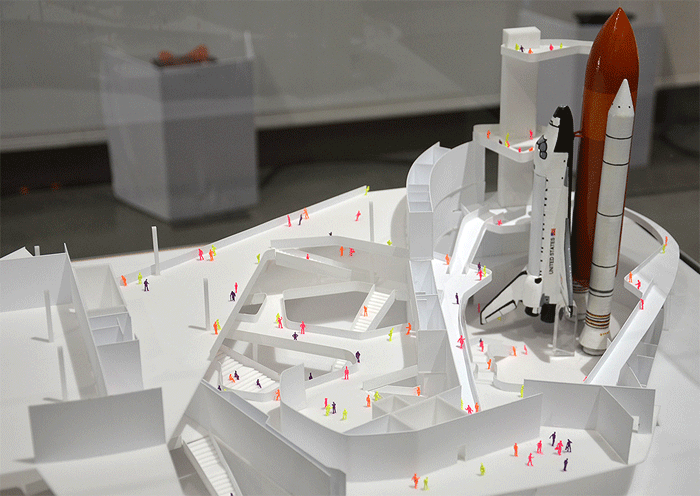
This model reveals the planned design for the Samuel Oschin Air and Space Center, Endeavour's vertical exhibit.
.
The twin solid rocket boosters, previously displayed at the Kennedy Space Center in Florida, were delivered by truck to California in 2012. Currently held at NASA's Armstrong Flight Research Center, they will be moved to the science center closer to when stacking operations are set to begin.
First though, ET-94 needs to arrive.
"We've dreamed of displaying a full stack of real hardware since the development of our master plan in 1992," stated Rudolph. The tank's journey to the science center, and its subsequent reunion with the orbiter, will be historic."
"With the same outpouring of community support we saw with the arrival of Endeavour," he said, "we look forward to celebrating this gift from NASA."
Quelle: SC
.
Update: 11.04.2016
.
Photos: Final space shuttle fuel tank relic heads for California
The last remaining external fuel tank built for the space shuttle program but never flew will depart its factory in New Orleans on Tuesday for a long sea voyage to the California Science Center in Los Angeles.
These pictures courtesy of the California Science Center show the tank being readied to leave the Michoud Assembly Facility where Lockheed Martin technicians originally built the tank.
The leftover tank, known as ET No. 94, will be the structural backbone of the space shuttle Endeavour vertical exhibit opening in 2019 to display the spaceship as if she was on the launch pad.
The barge carrying the tank will traverse the Panama Canal en route to California over the next several weeks. Arrival in Marina del Ray is scheduled for around May 19.
The tank will parade through 16 miles of Los Angeles city streets on May 21 to reach the museum for restoration and construction of the space shuttle attraction at the California Science Center’s new Samuel Oschin Air and Space Center.
.
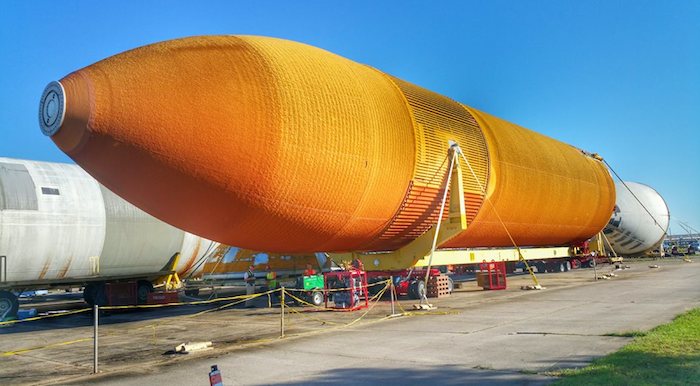
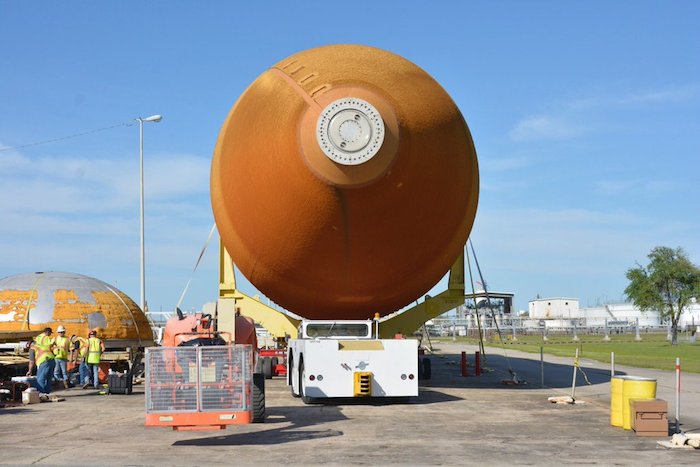
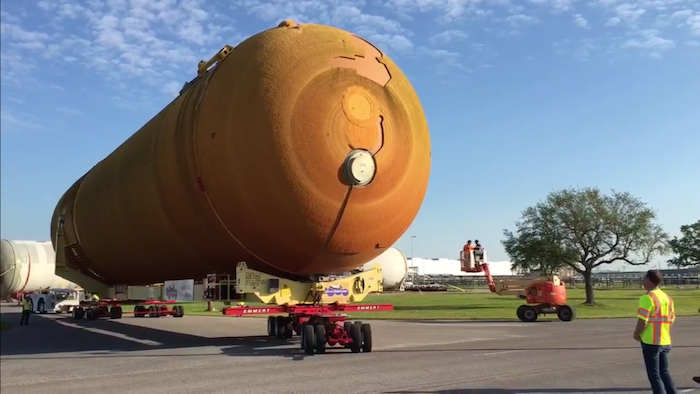
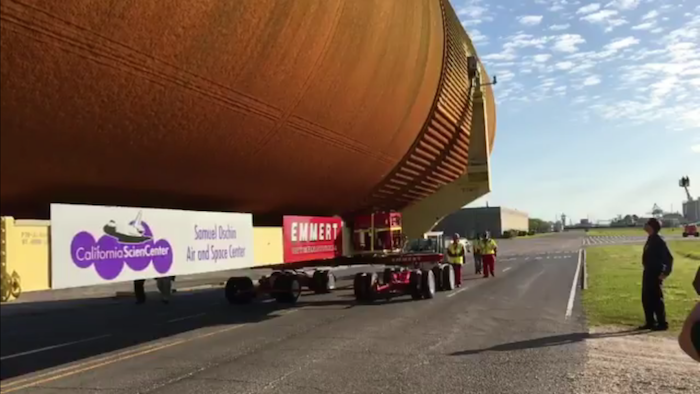
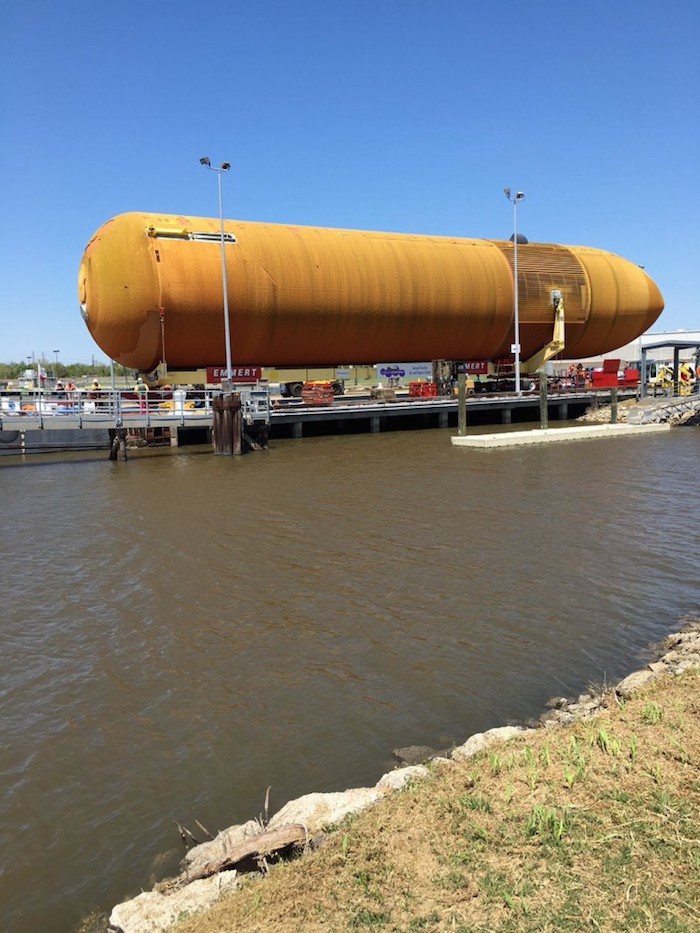
Quelle: SN
-
Last NASA space shuttle external tank set for LA to L.A. sea voyage
April 11, 2016 — A last-of-its-kind, very large artifact from NASA's space shuttle program is set to leave New Orleans this week on an almost 40-day ocean voyage to Los Angeles via the Panama Canal.
The remaining external tank built to fuel a space shuttle's launch into Earth orbit was rolled down a one mile-long (1.6 km) road and onto a barge on Sunday (April 10), two days ahead of its scheduled departure from NASA's Michoud Assembly Facility in Louisiana.
"It is a bittersweet day, [but] at the same time we like to celebrate history of the work that was done by the men and women here," said Bobby Watkins, director of the Michoud Assembly Facility. "With it moving over to California, that is going to open it up for millions of people to come and take a look at it, so we're very proud of that."
The 154-foot-long (47 m) orange-brown tank is destined for the California Science Center, where it will be mated with NASA's retired orbiter Endeavour and a pair of solid rocket boosters to create a unique vertical display of a fully-authentic space shuttle stack. The exhibit, to be erected in the Science Center's planned Samuel Oschin Air and Space Center, is slated to open to the public in 2019.
Endeavour was delivered to Los Angeles in 2012 atop a NASA modified Boeing 747 jumbo jet and then was driven through the streets of Los Angeles to its display pavilion at the Science Center. An aircraft was not an option for the external tank, and so it is taking a circuitous route, crossing from the Atlantic to Pacific Ocean by way of the Panama Canal. Coming on shore at Marina del Rey, it will then spend a night traversing city streets to join the orbiter at the museum.
The tank is scheduled to arrive at the California Science Center on May 21.
The structural backbone of the space shuttle, the external tank was the vehicle's only major component that was discarded and destroyed with each launch. Over the course of the 135-mission space shuttle program, 136 flight-qualified external tanks were assembled at the Michoud facility. Just one of those tanks, no. 94 (ET-94), went unused and so it exists today to be shipped to Los Angeles.
ET-94, a "lightweight tank," was built at a time when NASA was transitioning to using even lighter "super lightweight tanks" to launch the heavier parts needed for the International Space Station. ET-94 may have launched a science mission were it not for the loss of the orbiter Columbia in 2003.
Instead, it became a test article, used to validate modifications made to the tanks that enabled the shuttle fleet to safely return to flight after Columbia. As part of that work, sections of insulating foam were removed, which can be seen on the tank in its current state.
Once at the Science Center, ET-94 will undergo a partial restoration, including the re-installation of feedlines and other hardware that were earlier removed by NASA. Foam repairs will also be applied to the tank's exterior.
First though, ET-94 has to leave for Los Angeles. A small ceremony, closed to the public, is scheduled for Tuesday afternoon, where Jody Singer, the deputy director of NASA's Marshall Space Flight Center, will sign over ownership of the tank to the California Science Center, represented by president Jeff Rudolph.
.
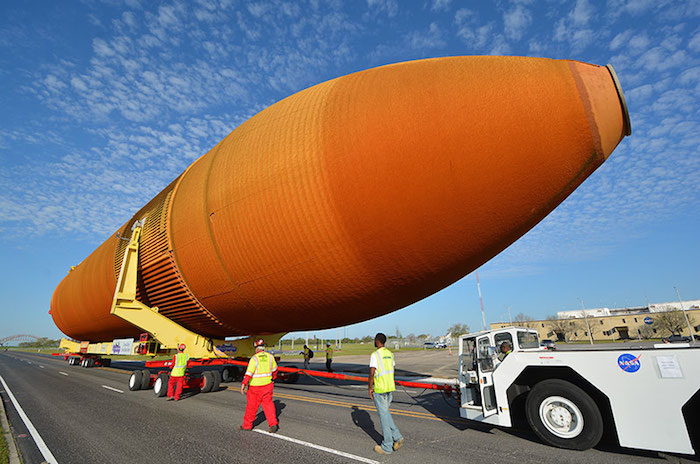
Quelle: CS
-
Update: 28.04.2016
.
Photos: Space shuttle fuel tank in Panama for passage through canal
-
The last space shuttle external tank in existence, headed from the New Orleans manufacturing plant to the California Science Center for the vertical launch pad display of the retired orbiter Endeavour, has passed through the Panama Canal.
The Shannon Dann tugboat pulling the Gulfmaster I barge loaded with External Tank No. 94 arrived at the canal’s northern inlet on Saturday. It traversed the initial portions of the 48-mile-long canal on Monday and reached the Pacific Ocean on Tuesday.
.




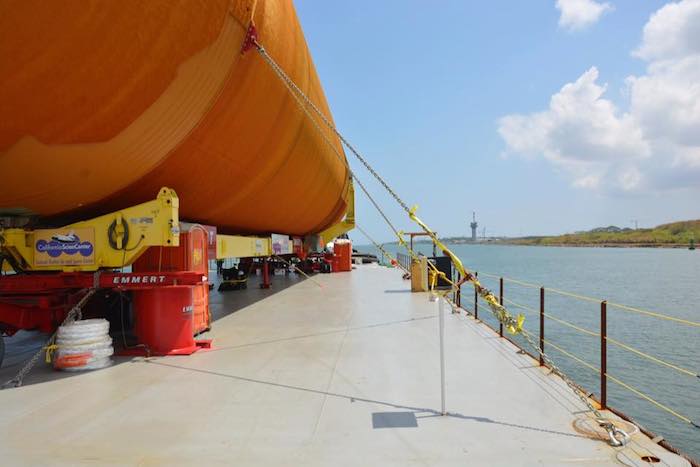
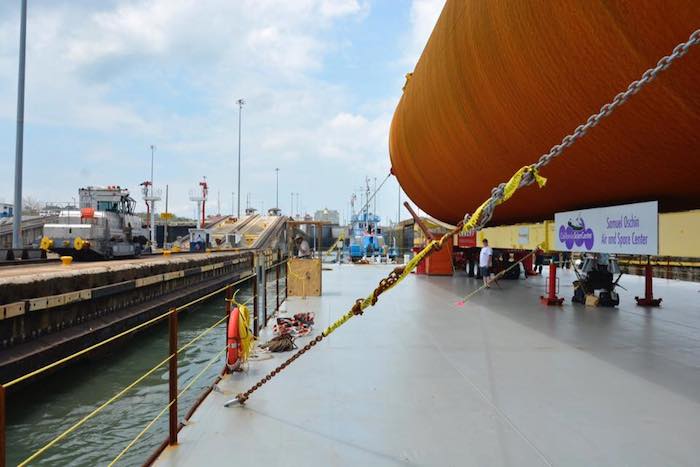
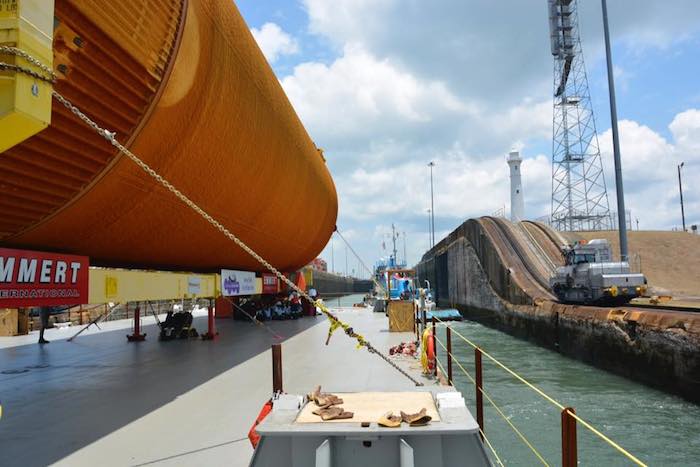
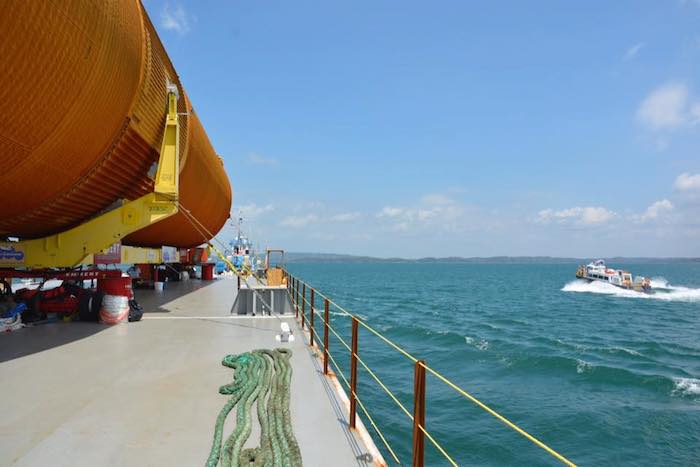

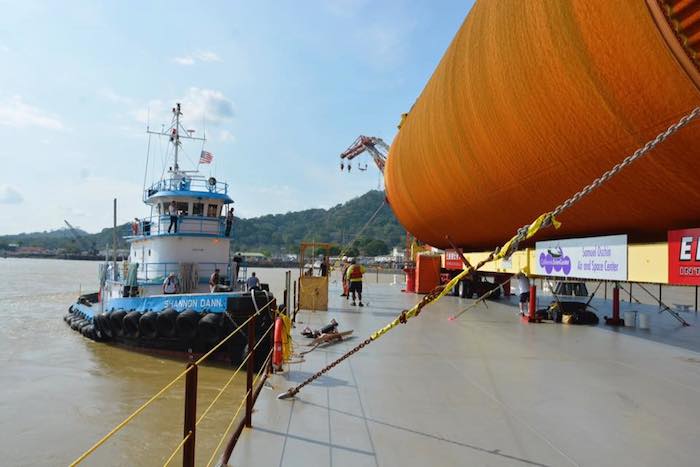
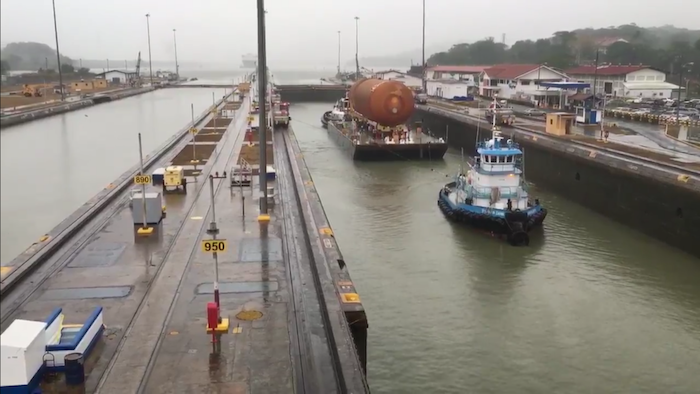
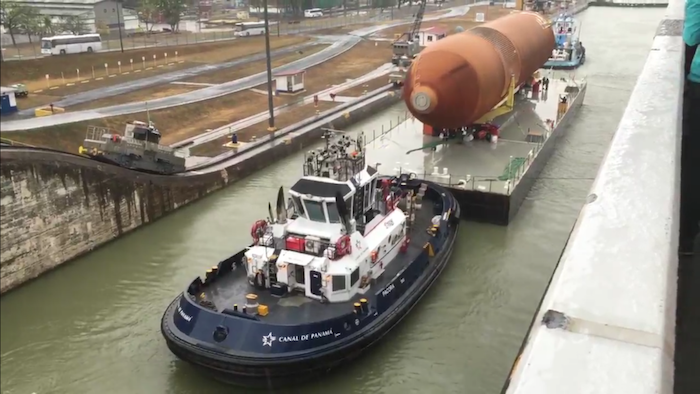
Quelle: SN
-
Update: 19.05.2016
.
Shuttle fuel tank comes ashore in California for Endeavour museum exhibit
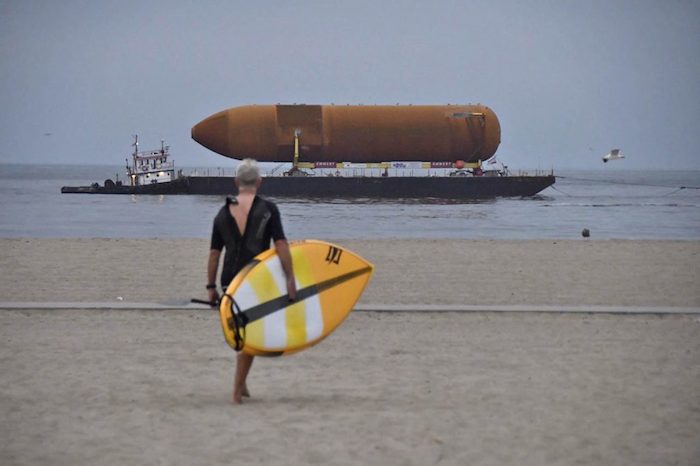
A five-week, 5,000-mile sea trek of the last space shuttle external fuel tank pulled into port today for a parade through the urban jungle of Southern California on Saturday to its final destination.
Originally built for a shuttle mission but never flown, the last-of-its-kind tank was donated to the California Science Center to use in its vertical launch pad attraction being designed with the retired orbiter Endeavour.
External Tank No. 94 left NASA’s Michoud Assembly Facility in New Orleans on April 12, sailed through the Panama Canal on April 25 and 26 and arrived in Marina del Rey, California, this morning.
The journey was performed by Emmert International, a commercial shipping firm based in Oregon.
Along the way, the tank transport rode out a storm in the Cayman Islands and then made a life-saving rescue off the coast of Mexico when a nearby charter fishing boat took on water and sank with four people aboard.
Under overcast skies at daybreak today, the tank was spotted just off the Los Angeles coastline and was greeted by a water cannon aboard an LA County fire boat while entering the harbor. The barge docked at 8 a.m. and workers offloaded the tank shortly before 10:30 a.m. using a semi-truck with an “ET XING” crossing sign on its grille.
The public can see the tank at the marina through Friday.
“Come out to Marina del Rey this week to get a look,” said Los Angeles County Supervisor Don Knabe. “It is just unbelievable the size of this tank.”
.
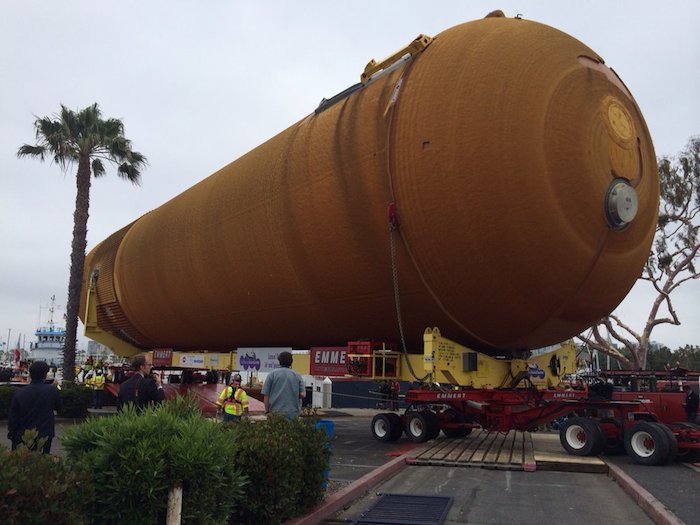
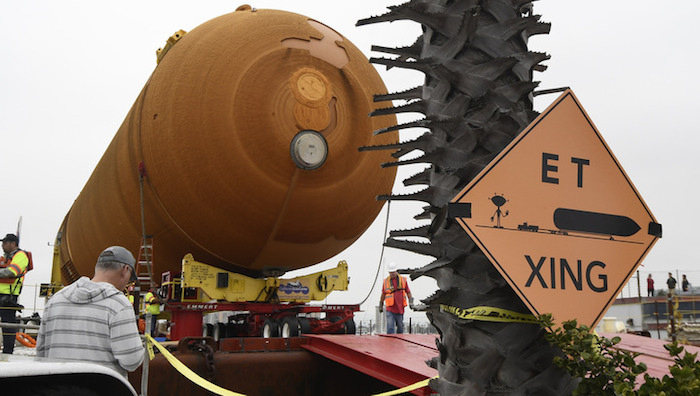
An official welcoming ceremony is planned for Friday night ahead of Saturday’s 16-mile city drive to the museum.
Each year, the California Science Center holds an annual fundraising gala, but this year’s “Discovery Ball” will be held at Marina del Rey with ET-94 as the star.
The gala’s theme will incorporate elements from New Orleans and Panama, key areas to the tank’s journey to California.
Also on Friday, the Department of Beaches and Harbors will hold a “Party in the Park” for the public at large with a DJ, food trucks, space-themed carnival games and science exhibits from 5 to 9 p.m.
On Saturday morning at 12:01 a.m. local time (3:01 a.m. EDT; 0701 GMT), ET-94 will leave the Fisherman’s Village area of the Marina trailing a New Orleans jazz band.
It is anticipated that the tank will travel at a walking speed and take 18 to 20 hours to reach Exposition Park on Saturday evening.
Crews traveling ahead of the tank will take down utility lines, signals and street signs, as needed, to ensure safe passage of the artifact.
The top cruising speed could reach as high as 5 mph, but navigating tight turns may take 45 minutes each.
Officials anticipate the convoy will reach Exposition Park around 8 p.m. local time (11 p.m. EDT; 0300 GMT) where a special “finish line” photo opportunity will be held. However, another activity in the park and the exact arrival time will determine when the tank can be positioned next to the Samuel Oschin Pavilion where Endeavour is located.
.

he parade’s route from the dock to the California Science Center in Exposition Park, adjacent to the LA Memorial Coliseum:
Marina Del Rey parking lot to Fiji Way
Fiji Way to Lincoln (PCH)
-Lincoln to Mindanao Way
Mindanao Way to CA-90
CA-90 to Culver Blvd.
Culver Blvd. to Lincoln via transition ramp
Lincoln to Loyola Blvd
Loyola Blvd. to Westchester Pkwy
Westchester Parkway turns into Arbor Vitae St. at Airport Blvd; Arbor Vitae St. to La Brea Ave
La Brea Ave. to Manchester Blvd
Manchester Blvd. to Vermont Ave
Vermont Ave. to Martin Luther King Blvd.
Martin Luther King Blvd. to Exposition Park.
The California Science Center’s official time estimates for when to expect the tank to pass by specific locations: (All projected times are subject to change; all listed in local time)
Leave the marina – Approximately 12:01 a.m.
Arbor Vitae between Inglewood Ave. and Rosewood Ave. – Approx. 8:00 to 9:30 a.m.
Forum – Approx. Noon to 2 p.m.
Manchester & Vermont – Approx. 2:30 to 4:00 p.m.
Vermont & MLK – Approx. 6:30 to 8:00 p.m.
Expo Park – Approx. 7:30 to 9:00 p.m.
The tank will go on public display at the museum upon arrival to the north-side of Endeavour’s pavilion. Technicians will perform extensive restoration work on the tank and re-install its missing nose cap, orbiter attachment hardware and the fuel and pressurant lines.
The launch pad display using the Endevour, the tank and a pair of solid rocket boosters is slated to open in 2019.
Quelle: SN
-
Update: 22.05.2016
.
Space shuttle tank move: ET94 arrives home
-
The fuel tank arrived at Exposition Park at about 6:15 p.m. It sailed through its route from Marina Del Rey to the California Science Center, arriving far ahead of schedule.
Shortly after 7 p.m., thousands of spectators cheered, whistled and waved American flags as the tank inched its way to its final destination beside a pavilion housing the Space Shuttle at Exposition Park.
Among them was Monty Icenogle, 36, who traveled from Bakersfield. Icenogle, who has been blind since birth, is a Space Shuttle buff.
“I wouldn’t miss this for the world,” he said, as the immense fuel tank was being nestled into its new home just 100 yards away. “This will never happen again, but because it did today, we are now in the only place on earth where you will be able to admire a space shuttle in full launch configuration.”
“So, its final mission accomplished,” he said with a smile. “How cool is that?”
-
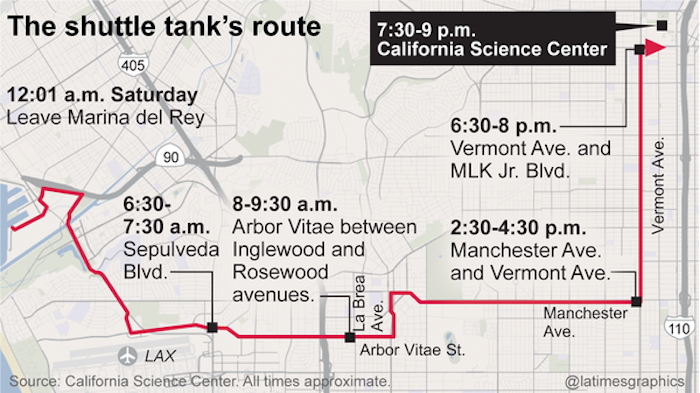
The giant orange fuel tank, called ET-94, is on its final stretch. Its expected arrival is now forecast between 5:30 p.m. and 7 p.m.
.
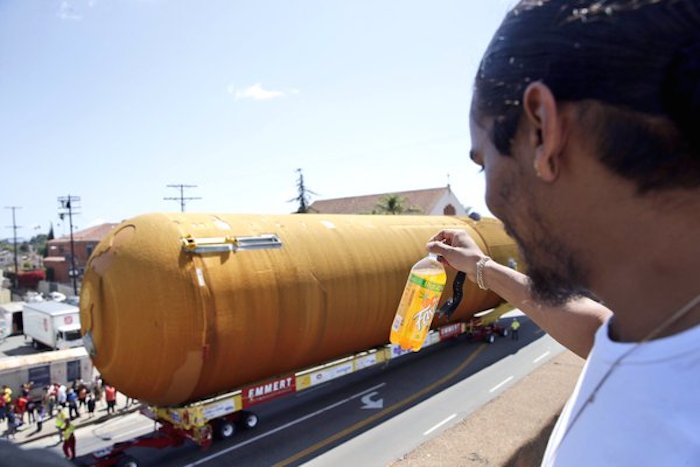
-
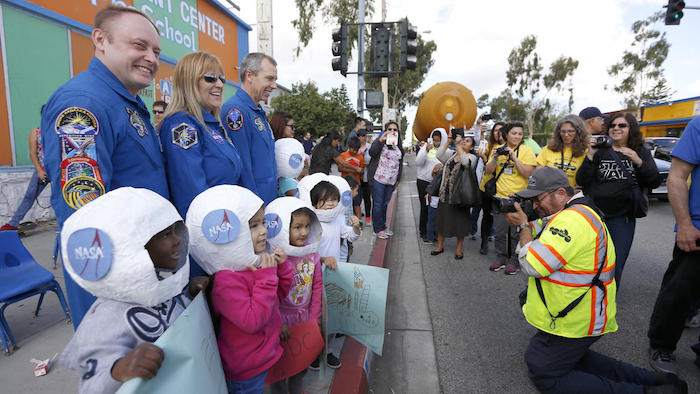
Mioko Lollis, 32, said her 11-year-old son, Jamier Flowers, had been talking for days about seeing the tank as it passed just a block from their home.
"This is like a once in a lifetime thing to see it," Lollis said. "I remember watching it on the news, but for him, this is history."
Flowers peered down the street. "It's getting closer, Mom!" he said. "I can see it!"
-
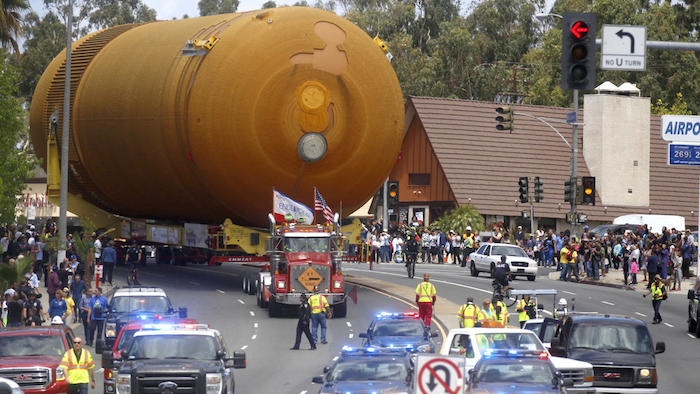
As the tank rumbled north like a huge orange torpedo toward downtown, Eric Finister, 51, tightened his grip on a walking cane and weighed his words carefully.
“You’d think something this darn big couldn’t get off the ground,” he said. “Yet it lifted off of the face of the Earth and soared into the heavens to fetch new knowledge for mankind.”
He paused, then smiled, and added, “Look what we can do when we put our minds to it.”
.

-
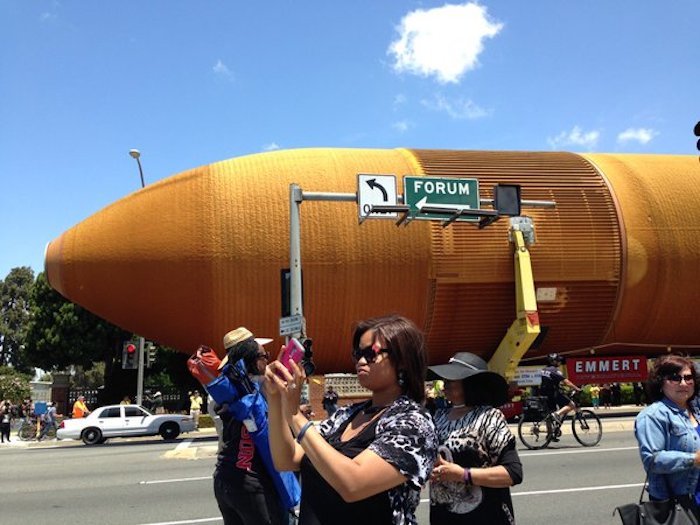
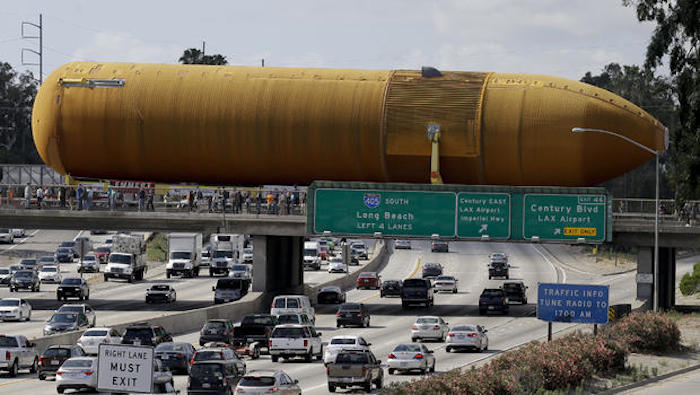
Quelle: Los Angeles Times
6433 Views
